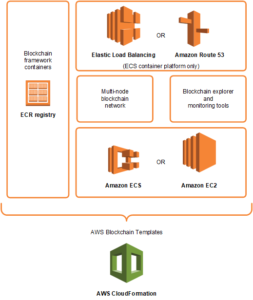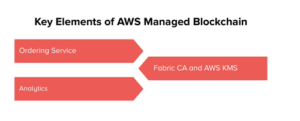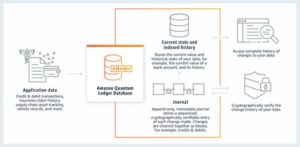Blockchain technology has emerged as a transformative force across various industries, allowing for secure, decentralized transactions and data management. One of the leading platforms harnessing this technology is AWS Blockchain. This guide explores AWS Blockchain, its features, benefits, and potential use cases, along with practical tips for getting started.
What is AWS
AWS, or Amazon Web Services, is a comprehensive cloud computing platform offered by Amazon that provides a wide array of services and solutions, including computing power, storage options, and networking capabilities. It enables businesses to deploy applications, store data, and manage resources with flexibility and scalability.
Within this expansive ecosystem, AWS Blockchain stands out as a powerful solution that allows organizations to create and manage blockchain networks easily. By leveraging AWS, businesses can harness the transformative power of blockchain technology, facilitating secure and decentralized transactions while optimizing their operations across various sectors.
What is AWS Blockchain?

AWS Blockchain refers to a suite of services provided by Amazon Web Services that facilitates the creation, management, and scaling of blockchain networks. This powerful technology enables multiple parties to execute transactions without relying on a central authority, ensuring data integrity and security.
Understanding Blockchain Technology
At its core, blockchain is a distributed ledger technology (DLT) that records transactions across multiple computers in a manner that prevents alteration. Each transaction is grouped into a block, which is then linked to the previous block, creating an immutable chain. This structure enhances transparency and trust among network participants.
Key Components of AWS Blockchain

1. Amazon Managed Blockchain
Amazon Managed Blockchain is a fully managed service that simplifies the setup and management of blockchain networks. Users can deploy networks using popular frameworks like Hyperledger Fabric and Ethereum with just a few clicks, eliminating the complexities typically associated with blockchain management.
Benefits of Amazon Managed Blockchain
- Scalability: Automatically scales to meet the demands of thousands of applications and millions of transactions.
- Ease of Use: The user-friendly console allows for easy management of members, permissions, and network configurations.
- Cost-Efficiency: Reduces operational overhead associated with maintaining infrastructure.
Learn more about Amazon Managed Blockchain.
2. Amazon Quantum Ledger Database (QLDB)

Amazon QLDB is a fully managed ledger database that provides a transparent, cryptographically verifiable transaction log. It is designed to maintain a complete history of changes made to application data.
Use Cases for QLDB
- Supply Chain Tracking: QLDB can store data about the journey of products, ensuring visibility and accountability.
- Financial Transactions: Ideal for applications requiring a secure and auditable record of transactions.
Discover more about Amazon QLDB.
3. AWS Blockchain Templates
AWS Blockchain Templates allow users to quickly create and deploy blockchain networks using predefined configurations. These templates support Ethereum and Hyperledger Fabric, making it easier to get started with blockchain applications.
Advantages of Using Blockchain Templates
- Rapid Deployment: Streamlines the process of launching blockchain networks.
- Pre-Configured Settings: Reduces the need for extensive configurations, enabling faster project initiation.
Explore the options available with AWS Blockchain Templates.
Features of AWS Blockchain
Immutable Data Storage
One of the most compelling features of AWS Blockchain is its ability to provide immutable data storage. Once data is recorded on the blockchain, it cannot be altered or deleted. This guarantees data integrity and builds trust among users.
Decentralization
AWS Blockchain operates on a decentralized model, distributing data across multiple nodes. This eliminates the risk of a single point of failure and enhances security, as no single entity controls the entire database.
Built-In Security
AWS ensures that blockchain networks are secure by implementing encryption for data at rest and in transit. Additionally, AWS Identity and Access Management (IAM) provides robust access controls to ensure that only authorized users can interact with the blockchain.
Flexible Framework Support
AWS Blockchain supports multiple frameworks, including:
- Ethereum: Ideal for applications requiring smart contracts.
- Hyperledger Fabric: Best suited for enterprise-grade solutions requiring permissioned access.
AWS Blockchain pricing
Benefits of AWS Blockchain
Reduced Operational Costs
By leveraging AWS Blockchain, businesses can significantly reduce the costs associated with managing and maintaining their blockchain infrastructure. AWS handles the underlying resources, allowing companies to focus on building their applications.
Enhanced Performance
The ability to automatically scale resources means that AWS Blockchain can handle fluctuations in transaction volume without sacrificing performance. This ensures that applications remain responsive and reliable.
Simplified Management
The user-friendly interface provided by Amazon Managed Blockchain allows users to easily monitor network activity, track performance metrics, and manage permissions, making it accessible even for those without extensive technical expertise.
Common Use Cases for AWS Blockchain
1. Supply Chain Management
AWS Blockchain is particularly effective in supply chain management, where it can be used to track the movement of goods from manufacturers to consumers. This transparency helps reduce fraud and improves overall efficiency.
2. Financial Services
In the financial sector, AWS Blockchain can streamline payment processing, enabling faster transactions while maintaining security and compliance. This is especially beneficial for industries like banking and insurance.
3. Healthcare Data Management
AWS Blockchain can securely manage and share sensitive healthcare data, such as patient records. This facilitates collaboration between healthcare providers and researchers while ensuring patient privacy.
4. Digital Identity Verification
Blockchain technology can create secure and decentralized systems for identity verification. This can enhance security in sectors like finance and e-commerce, where identity fraud is a concern.
Getting Started with AWS Blockchain
Step 1: Define Your Use Case
Before diving into AWS Blockchain, clearly define your objectives. Determine how blockchain can address your specific business needs and identify the stakeholders involved.
Step 2: Choose the Right Framework
Based on your requirements, select an appropriate framework. Whether you need Ethereum for smart contracts or Hyperledger Fabric for enterprise applications, AWS offers the flexibility to choose.
Step 3: Set Up Your Network
Utilize Amazon Managed Blockchain to set up your network quickly. Follow the step-by-step instructions in the AWS Management Console or use AWS CLI for more advanced configurations.
Step 4: Deploy Applications
Once your network is up and running, deploy your applications. Utilize AWS services to enhance your blockchain solutions, such as using Amazon S3 for storage or Amazon CloudWatch for monitoring.
Best Practices for Using AWS Blockchain
Regularly Monitor Your Network
Utilize Amazon CloudWatch to monitor the performance of your blockchain network. Regular monitoring helps identify potential issues before they escalate.
Implement Strong Security Measures
Always enforce strong access controls using AWS IAM. Regularly review permissions and ensure that only authorized users can access sensitive data.
Optimize for Cost Efficiency
Utilize AWS Cost Management tools to track your spending on blockchain services. Optimize resource allocation based on usage patterns to avoid unnecessary costs.
Potential Limitations of AWS Blockchain
While AWS Blockchain offers numerous benefits, it is important to be aware of potential limitations:
- Complexity: Although AWS simplifies blockchain management, some aspects may still be complex for beginners.
- Costs: Depending on usage, AWS Blockchain services can become costly, especially for high-volume applications.
- Regulatory Considerations: Businesses must navigate regulatory landscapes, which may vary by industry and region.
AWS blockchain certification
Login aws blockchain templates
To effectively utilize AWS Blockchain Templates, users must first log in to their AWS Management Console. This straightforward process grants access to a variety of pre-configured templates that simplify the creation and deployment of blockchain networks, whether using Ethereum or Hyperledger Fabric. By logging in, users can quickly select the appropriate template tailored to their specific use case, facilitating a faster setup for their blockchain projects.
The user-friendly interface of the console guides users through the necessary steps, allowing them to customize configurations and manage their networks efficiently. Leveraging AWS Blockchain Templates can significantly reduce the time and complexity involved in launching blockchain applications, making it an ideal solution for organizations eager to harness the power of blockchain technology.
The Benefits of AWS Manage Blockchain
Conclusion
AWS Blockchain represents a powerful solution for businesses looking to leverage blockchain technology. With its array of features, including scalability, security, and ease of use, it provides a robust platform for various applications across industries. By understanding the components, benefits, and best practices associated with AWS Blockchain, organizations can harness its full potential to drive innovation and efficiency.
Frequently Asked Questions (FAQ)
What is AWS Blockchain?
AWS Blockchain is a suite of services by Amazon Web Services that enables the creation and management of scalable blockchain networks.
What are the main components of AWS Blockchain?
The main components include Amazon Managed Blockchain, Amazon Quantum Ledger Database (QLDB), and AWS Blockchain Templates.
How does Amazon Managed Blockchain work?
Amazon Managed Blockchain simplifies the setup and management of blockchain networks, allowing users to deploy networks with minimal effort.
What are the benefits of using AWS Blockchain?
Benefits include reduced operational costs, enhanced performance, simplified management, and improved security.
Can AWS Blockchain be used for supply chain management?
Yes, AWS Blockchain is particularly effective for supply chain management, offering transparency and traceability.
Is AWS Blockchain secure?
Yes, AWS implements robust security measures, including encryption and access controls, to ensure the integrity of blockchain networks.
What frameworks does AWS Blockchain support?
AWS Blockchain supports frameworks like Ethereum and Hyperledger Fabric.
You may also like:














Post Comment